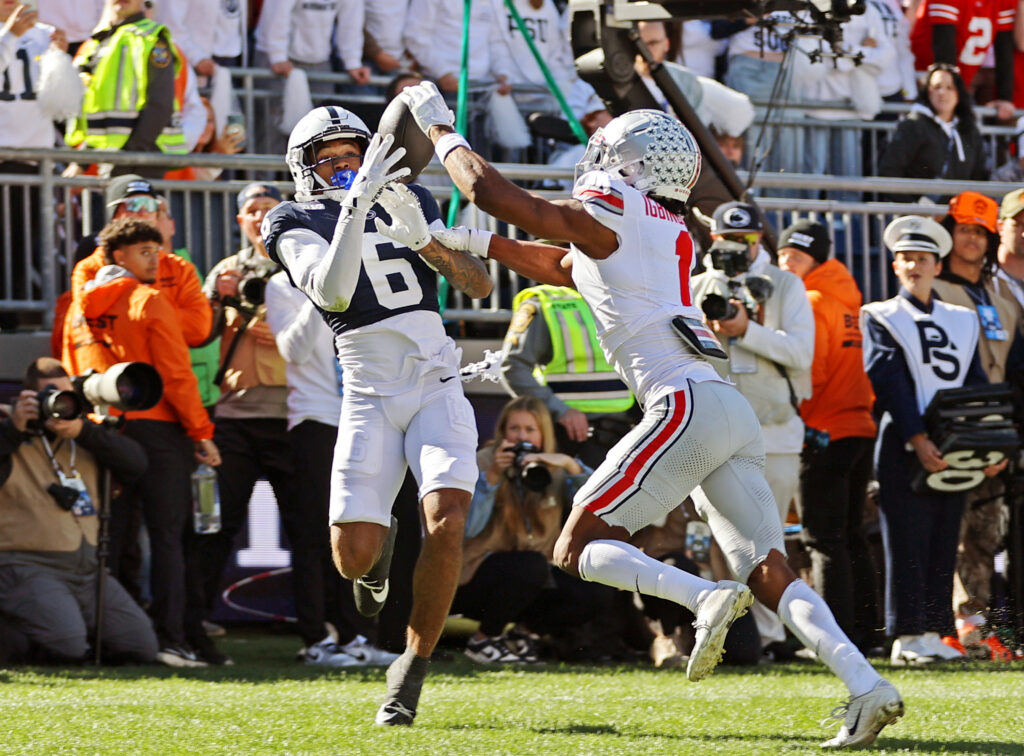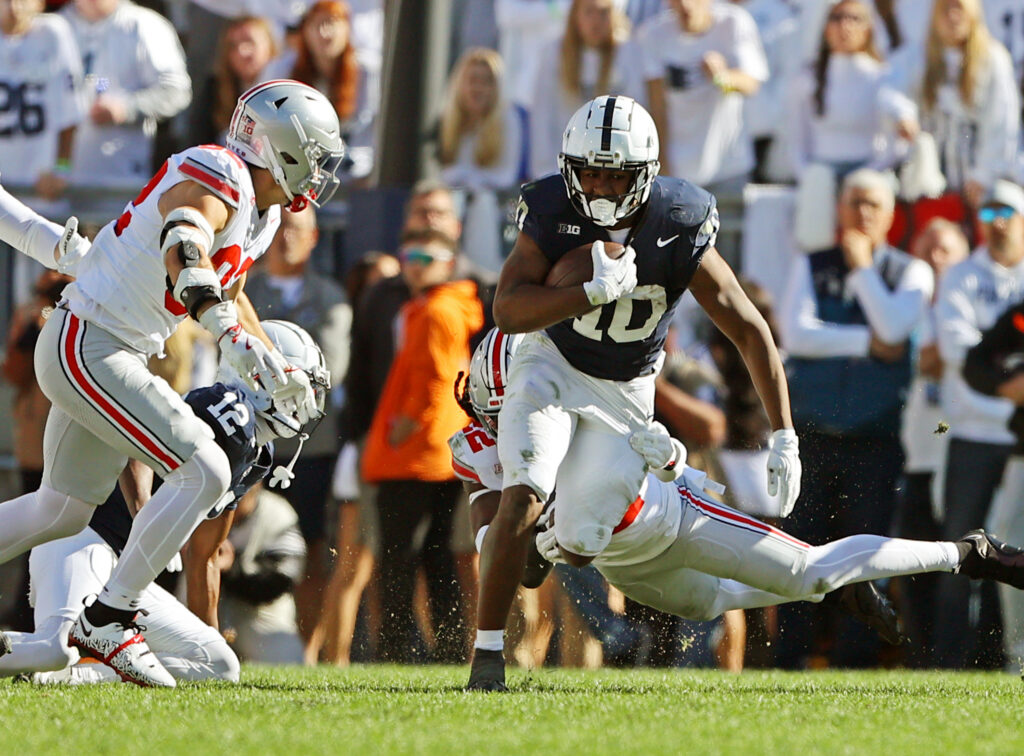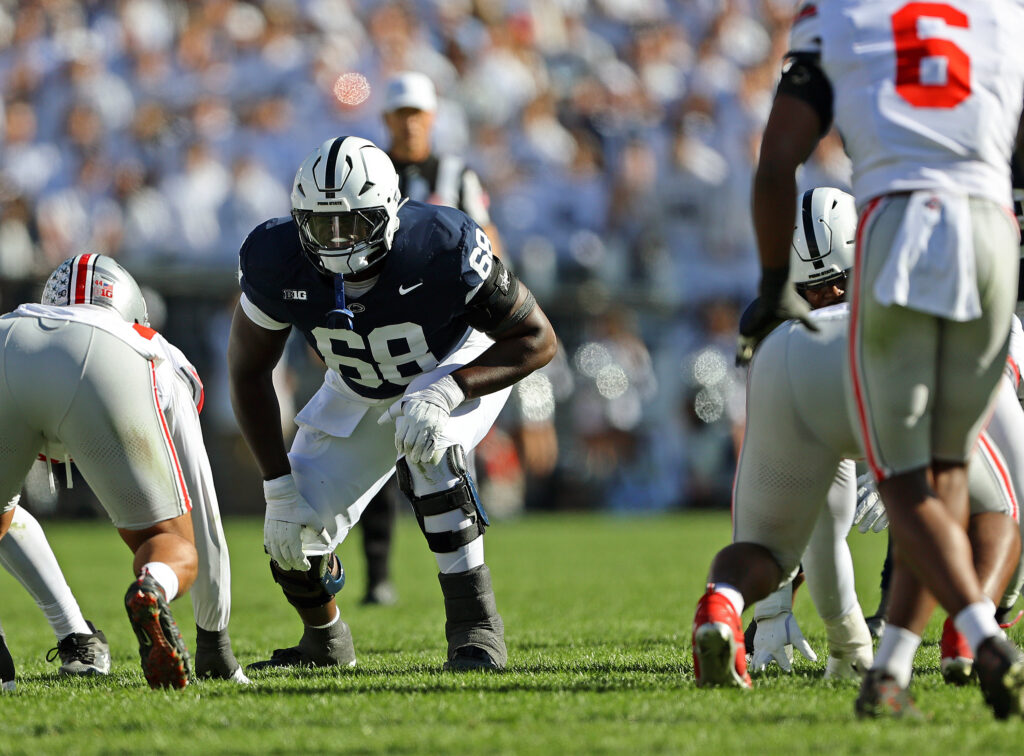The stage could not have been bigger. On a day that saw Penn State become the epicenter of college football, a day that players and coaches felt confident would mark the team’s official initiation into sport’s elite tier, the Nittany Lions fell short, again. Another loss, 20-13, against a vulnerable Ohio State team that remains more capable than James Franklin’s program.
“There’s a lot of things that I had planned on saying when I came in here today, but they are not appropriate to say right now, so I will hold them till another time,” said Franklin, who will have to wait another year to follow up on the promise he made in 2018 — that his team will ascend from great to elite.
The act is aging. A loss to the Buckeyes has become an almost annual occurrence for Franklin since becoming Penn State’s head coach in 2014. But this one was seemingly a tougher pill for players and fans alike to swallow based on how far the Nittany Lions have come, how close they were to finally getting over the dreaded Ohio State hump.
It was a game that was in reach. Just yards away. Just one less penalty away. Just one play call away from leaving the past eight oh-so-close years in the rearview. The final offensive possession, three straight rushes and a botched pass attempt at the goal line, epitomized the reality of Franklin’s teams for the better half a decade: so close, but so far.
“I will say this, and I’ve said it before, 99% of the programs across college football would die to do what we’ve been able to do in our time here,” Franklin said. But it’s the 1% of teams that wouldn’t celebrate anything but perfection that he’s tried desperately to reach. Saturday was as good a chance as ever. So why is Penn State still on the outside looking in?
Here are some final thoughts on the loss to the Buckeyes.
The sad reality: There is no WR1
It’s Groundhog Day. The weak link of the Nittany Lions’ offense, a unit now led by one of the nation’s most creative minds in Andy Kotelnicki, is wide receiver. Harrison Wallace III, Liam Clifford, Julian Fleming and Omari Evans are all good, but none are good enough to consistently beat defenders and take over a game.
There’s a reason just two wide receivers touched the ball for a total of three catches against Ohio State. A team that once produced annual talent at wide receiver, from Chris Godwin to DaeSean Hamilton to KJ Hamler to Jahan Dotson, has fallen stagnant for two years, both in recruiting success and player development.
Franklin and Kotelnicki were both asked preseason whether they believed Wallace had stepped into the same shoes as the team’s No. 1 wide receiver. They both shared “excitement” about Wallace, but neither were ready to anoint him with the title Franklin had asked KeAndre Lambert-Smith to play under last season.
That’s because Wallace isn’t the No. 1 wide receiver. Tyler Warren is, and he’s not a wide receiver at all. Warren is one of the nation’s best tight ends and most versatile players, period. But without a durable wide receiver to space the offense beside him, the Nittany Lions can only find so much success offensively. That was made clear against the Buckeyes.

Drew Allar can’t do it alone
For that very reason, it’s hard to blame Drew Allar, one of the most talented quarterbacks in the program’s history, for Saturday’s shortcomings. Much like his first crack against Ohio State, Allar struggled to complete passes in the face of a multi-faceted secondary. Not because he isn’t capable of doing so, but because he frankly has no one, other than Warren, to throw to.
Nick Singleton, a running back, was Penn State’s leading receiver on Saturday. Warren followed closely behind him. While getting a running back and tight end heavily involved in the pass game is important, it hardly means anything if the opposing defense knows the passing offense is limited to those two positions.
It’s difficult not to think about what could’ve been if a talented arm like Allar had an equally talented wide receiver to throw to. That aspect is quite literally the difference between the Nittany Lions and Buckeyes, who have had no shortage of wide receiver threats over the past decade. Penn State simply lacks the talent at that position to compete with the nation’s best.
Run game has lost its spark
Singleton and Kaytron Allen looked like the dynamic running back duo of old over the first four games of the year. Since then, both have dipped off. Could that be a concern with the offensive line? Sure. But the fact still remains, Kotelnicki found early success with both, and has struggled to create explosive opportunities over the past month.
Singleton was sidelined with an injury for Penn State’s 27-11 win over UCLA on Oct. 5, and hasn’t looked the same since. His carries are down, as is his rushing production. Singleton’s six carries for 15 yards, a 2.5 yards per attempt average, was a season low. Warren was the team’s leading rusher with three carries for 47 yards.
That also begs the question: Why did the Nittany Lions opt to rush Allen three consecutive times on their final goal-line stand without giving Warren a single opportunity? Franklin said postgame he understands the question, but did not elaborate further. Either way, a winning team shouldn’t have to rely on its tight end to be its best running back and wide receiver.

Pointless penalties kill momentum
The momentum shifted when Elliot Washington II stepped over Ohio State’s Carnell Tate in the second quarter. What would’ve been a third-down stop, while still maintaining the lead, turned into a 15-yard gain on an unsportsmanlike conduct penalty. The Buckeyes then used the free yardage to storm downfield and score a go-ahead touchdown, their final.
Washington’s flag followed a third-down offsides penalty on defensive end Abdul Carter on the same drive. There were two opportunities to stall Ohio State on third down, and both were thrown away due to avoidable penalties that ultimately provided the Buckeyes with the score they needed to overcome Penn State for yet another year.
Zion Tracy scored the Nittany Lions’ only touchdown of the day. It was a pick-six on Ohio State quarterback Will Howard’s first pass attempt. An early 10-0 lead had Beaver Stadium, packed with a record 111,030 fans, buzzing. After the Buckeyes scored a touchdown on their next drive and another following the two flags, the momentum had shifted completely.
Dennis-Sutton limited, other injury notes
Allar played and appeared as mobile as ever, especially on Penn State’s first drive, and finished the game as the team’s second leading rusher with 10 carries for 31 yards. But what about the two starters who were ruled questionable prior to kickoff?
Neither right tackle Anthony Donkoh nor Dani Dennis-Sutton started on Saturday, but both played. Donkoh was sidelined for the first quarter in place of Nolan Rucci, but returned to action in the second quarter and played the rest of the game without any apparent trouble. Dennis-Sutton, meanwhile, only saw five snaps and did not play in the second half.

For the first time in over a month, injured safety Kevin Winston Jr. returned to the sideline as a spectator. Winston had a brace over his left knee, which was not present the last time he watched the Nittany Lions. He served as a game captain during the coin toss on Saturday.
Quinton Martin Jr., a true freshman who assumed third-string running back duties after Cam Wallace’s long-term injury, was ruled out prior to the game but dressed in uniform and warmed up before kickoff. That could be a promising sign in regards to his return.



